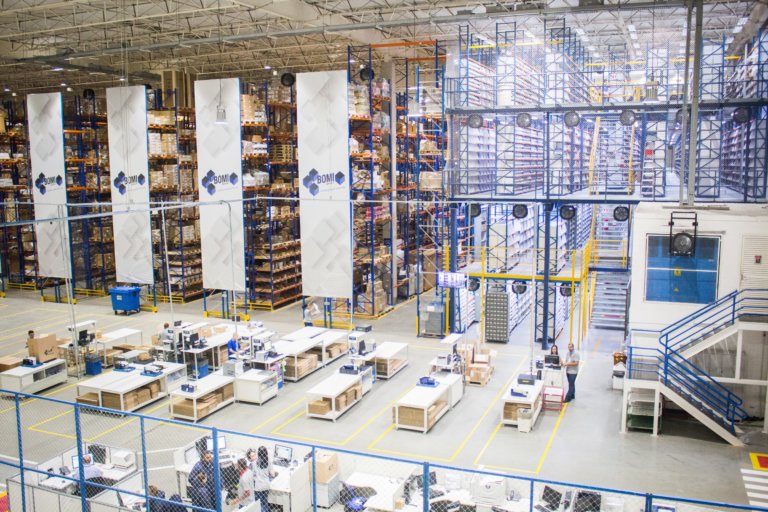From writing a business plan to purchasing trucking equipment, this article walks you through the key steps of how to start a trucking business.
Key Takeaways
- Choosing the right niche within the trucking industry is important for reducing competition and becoming an expert in a specific market.
- A detailed business plan will serve as a roadmap to guide your business decisions and is essential for securing financing.
- Familiarize yourself with FMCSA standards and regulations, including driver qualifications, cargo securement, and hours of service.
- On average, trucking companies can expect profit margins between 5% to 10%.
America’s supply chain depends on the trucking industry, which hauled a whopping 11.46 billion tons in 2022 alone.
And if you’re thinking about starting a trucking business, it’s a good time. According to Zippia, the US trucking market size was worth $217.3 billion as of 2022, and is projected to grow at a 3% compound annual growth rate through 2027.
But sorting the logistics of getting your new business off the ground can be challenging. Between fluctuating environmental regulations and upgrades in technology, there’s a lot to keep in mind.
In this article, I’m going over 10 essential steps to starting a trucking company in 2025 to help you navigate the process.
Choose the Right Niche
The most important step to starting and running a successful trucking business is to choose the right niche or market.
Specializing in a niche allows you to become an expert in that area and reduces direct competition. While many companies might offer general trucking services, fewer are likely to specialize in a particular type of freight or route.
Whether you’re dealing with refrigerated transport, flatbed hauling, or hazardous materials, understanding the unique requirements and regulations can help you operate your business more efficiently.
Here’s a list of 10 niches to consider:
- Refrigerated (Reefer) Trucking
- Flatbed Trucking
- Hazardous Materials (Hazmat) Trucking
- Heavy Haul Trucking
- Expedited Freight
- Tank Trucking
- Livestock Hauling
- Auto Transport
- Dry Bulk Trucking
- Intermodal Trucking
Did You Know?
According to the U.S. Department of Transportation, the leading products shipped by weight are natural gas and other fossil fuel products, including gasoline and nonmetallic mineral products. The leading products by value are goods such as electronics, clothing, footwear, and auto parts.
Create a Business Plan
Before you rush to buy a fleet of trucks and get out on the open road, make sure to do some research and planning to get a broader view of the industry and develop a basic trucking business plan.
A business plan is your roadmap to starting and running a successful truck company. It helps you stay focused, set clear goals, define your company values, and prepare for potential challenges. Not to mention you’ll need one if you plan to apply for credit or funding from investors.
Your business plan should be a clear, data-driven strategy that acts as a guide for all your business decision.
Here are some key points to cover in your business plan:
- Your trucking business overview. What is your business’ vision and mission and what services will it provide? Where will your fleet be based?
- Market analysis of the trucking industry. Who is the audience you plan to target, who are your competitors, and what advantages do they have?
- A marketing plan. Map out how you plan to market your trucking business, get new customers, and increase sales.
- Personnel and staff. How many staff members will you require to start your new business and what will their roles be? Who are your secondary clients and how can you diversify?
- Financial projections. Forecast your business’s revenue and expenses over the next 3-5 years
Pro Tip
Check out our complete article on how to write a business plan for a step-by-step breakdown of the process.
Choose a Legal Structure
Your next step will be deciding what type of business structure best fits your trucking company.
The four most common business structures for small businesses are limited liability corporations (LLC), corporations (C Corp), sole proprietorships, and partnerships.
Each has its own set of rules and regulations as well as advantages and disadvantages. Below is a brief explanation of each, but I highly recommend speaking with a lawyer or accountant to decide which structure best suits your business:
- Sole proprietorship: The simplest business structure, owned and operated by one person. Sole proprietorships offer minimal paperwork but comes with unlimited personal liability for business debts.
- Partnership: Co-owned by two or more people who share profits and losses. Offers some flexibility but can lead to partner disagreements and shared liability.
- Limited liability company (LLC): A hybrid structure combining some corporate benefits with simplicity. Includes limited personal liability for owners (called members) and relative ease of management.
- Corporation (C Corp): A separate legal entity from its owners (shareholders). Offers strong liability protection but comes with more complex regulations and potential double taxation.
Secure Financing
To get your business off the ground, you’ll need a solid financial business plan. But don’t let a lack of upfront capital keep you from starting your business. Many owner-operators secure funding through a mix of sources, such as bank loans and angel investors.
First, you’ll need to create a realistic budget, which you should already have from writing your business plan. Once you understand your financial needs, explore these funding options:
- Investors: Venture capitalists and angel investors provide capital in exchange for equity in your trucking business. This approach can be a good fit for high-growth trucking niches, but remember, you’ll be sharing some business control.
- Traditional bank loans: Banks offer loans with fixed interest rates and repayment schedules. To qualify, you’ll typically need a strong credit history and a well-crafted business plan.
- Government grants: Federal and state agencies might offer grants specifically for the trucking industry, often focused on supporting small businesses, innovative technologies, or safety initiatives. Research available grant programs to see if your trucking operation qualifies.
- Business credit cards: Credit cards provide immediate access to capital, making them ideal for covering initial expenses like licensing fees or unexpected repairs. However, be mindful of high-interest rates and prioritize on-time payments to avoid getting hit with high interest payments.
- Small Business Administration funding programs: The Small Business Administration (SBA) offers loans and grants specifically designed for startups. The loans often have lower interest rates and flexible repayment terms compared to traditional bank loans, but they’ll still require a strong business plan and good credit to get approved.
- Business line of credit: A line of credit acts like a revolving credit card with a pre-approved borrowing limit. Perfect for covering ongoing operational expenses like fuel or unexpected maintenance costs, you only pay interest on the amount you use. This option offers more flexibility than a traditional loan but requires good credit and established financials.
Register Your Business
Registering a new trucking company requires permissions from multiple government agencies. This is because trucking is a high-risk industry that requires specialized skills and regulatory compliance. Additionally, truckers frequently cross state lines, so businesses need to adhere to both federal and state regulations.
To successfully register your business, you’ll need to obtain permission from the following bodies:
- Federal Motor Carrier Safety Administration (FMCSA) Operating Authority: To operate legally, you need to get an FMCSA number and a USDOT number, which identifies your business for safety reports, compliance reviews, and other purposes.
- International Registration Plan (IRP): If you plan to operate across state lines, you must register your vehicle under the IRP. This allows you to pay road use taxes across multiple states.
- International Fuel Tax Agreement (IFTA): The IFTA requires interstate motor carriers to report and pay motor fuel taxes to a single base jurisdiction (usually the carrier’s home state or province), rather than having to deal with each jurisdiction separately. Carriers must obtain an IFTA license and display decals on each qualified vehicle, which typically are those with two axles and a gross vehicle weight over 26,000 pounds, or with three or more axles.
- Boc-3 Process Agents: These agents are designated individuals or companies authorized to receive legal documents (such as court papers, official notices, or subpoenas) on behalf of trucking companies in every state where they operate. This ensures that companies can be served with legal documents even if they don’t have physical presence in that state. All trucking companies that operate across state lines must file BOC-3 forms.
- Unified Carrier Registration (UCR): The UCR is a federal system that requires interstate motor carriers, freight brokers, leasing companies, and freight forwarders to register annually and pay a fee based on the size of their fleet. The revenue collected supports state-level transportation safety programs.
- Get an EIN number: Your employer identification number, or EIN, is like a social security number for your business. This nine-digit number is required to open a business bank account and must be present on all tax filings for the life of your business.
You can apply for an EIN using the IRS’ EIN Assistant Tool.
Pro Tip
Check out The Permit Shop’s complete checklist of all the necessary documents and permits you need to start your trucking business.
Get Insured
The Federal Motor Carrier Safety Administration (FMCSA) oversees the safety and compliance of commercial motor vehicles and carriers in the United State. It also mandates what types of insurance trucking companies need to carry.
The types of insurance you need vary based on the equipment you use and where your company operates, so I recommend working with an insurance agent to help you determine exactly which insurance plans are right for you.
You can also read about the insurance filing requirements on FMCSA’s website.
To give you an overview, I’ve listed some of the most important types of insurance below:
Primary liability insurance
- Purpose: Covers bodily injury and property damage to others in an accident where your driver is at fault.
- Requirement: Mandated by federal law or interstate trucking and by states for intrastate trucking.
- Minimum Coverage: Typically $750,000 to $1 million, but up to $5 million for hazardous materials.
Cargo insurance
- Purpose: Protects against loss or damage to the goods being transported.
- Requirement: Often required by shippers and brokers.
- Minimum Coverage: Varies, but a standard policy might cover $100,000 per load.
Physical damage insurance
- Purpose: Covers damage to your own trucks and trailers from collisions, theft, vandalism, and natural disasters.
- Types: Can be split into collision (accidents) and comprehensive (non-collision incidents).
Bobtail/non-trucking liability insurance
- Purpose: Covers liability when a truck is being operated without a trailer, typically when not under dispatch.
- Requirement: Often required by leasing companies.
General liability insurance
- Purpose: Covers bodily injury, property damage, and personal injury claims that occur during business activities not directly related to truck operations, such as at your office or warehouse.
- Coverage: Typically $1 million per occurrence and $2 million aggregate.
Workers’ compensation insurance
- Purpose: Provides medical benefits and wage replacement for employees injured on the job.
- Requirement: Required by law in most states if you have employees.
Trailer interchange insurance
- Purpose: Covers damage to trailers owned by others that you are using under a trailer interchange agreement.
- Coverage: Usually matches the value of the trailers in use.
Buy or Lease Equipment
You have the option of buying, leasing, or renting trucks and trucking equipment, but how do you decide which option is right for your business?
Buying is ideal if you plan to use the equipment long-term and want complete control over maintenance and customization. While ownership can offer tax advantages and help you build equity, it also involves higher upfront costs and long-term financial commitments.
Leasing, on the other hand, allows you to get the latest equipment with lower upfront costs and predictable monthly payments, making it easier to manage cash flow. Leasing often includes maintenance services which reduces downtime and repair expenses. This option is best if you prefer newer equipment and want to avoid the depreciation risks associated with ownership.
Renting offers maximum flexibility for short-term needs, and is ideal for handling seasonal peaks or project-specific requirements. It requires no long-term commitment, making it a smart choice if your equipment needs vary or if you’re testing different types of vehicles.
Duman Zhumagulov, CEO of Box Star Movers, says:
“I started by leasing trucks because it allowed me to conserve capital. Over time, as the business grew, I began purchasing equipment to build assets.“
To decide which option suits your business, consider factors like how long you plan to use the equipment, your cash flow, and the need for flexibility.
Companies like Maxim Truck & Trailer, Premier Truck Rental, and Idealease offer a range of trucks and trailers for purchase, lease, or rent. Evaluate your operational needs and finances to determine the most cost-effective and practical solution for your trucking company.
Average Costs of New Trucking Equipment:
- Semi tractor trucks: $80,000-$150,000
- Dump Trucks: $100,000-$200,000
- Box trucks: $30,000-$100,000
- Dry van trailers: $30,000-$60,000
- Flatbeds: $20,000-$50,000
- Refrigerated trailers: $50,000-$100,000
- Loading and unloading equipment, like forklifts: $20,000 -$50,000
- Dock levelers: $4,000-$12,000
- Tie-downs and straps: $100
Ensure Compliance With Regulations and Safety Protocols
As a trucking company business owner, it’ll be your responsibility to make sure your company and your drivers remain compliant with industry regulations and transportation safety standards.
To do so, you’ll first need to be aware of which regulations you need to adhere to. Speak with a lawyer or do extensive research on what laws apply to your trucking company, which may vary based on your market niche, location, and what type of equipment you use.
Truckers face several compliance regulations by federal, state, and local authorities. As a starting point, I recommend reading up on FMCSA’s regulations. The website also offers a helpful search feature where you can search for regulations by keyword and date.
Below, I’ve provided a list of some of FMCSA’s most important legal requirements:
- Commercial Driver’s License (CDL) Standards: Sets the requirements for obtaining and maintaining a CDL, including testing and endorsements for different types of cargo.
- Cargo Securement Rules: Establishes standards for securing cargo on CMVs to prevent shifting or falling during transport.
- Drug and Alcohol Testing: Mandates drug and alcohol testing for CMV drivers to ensure they are not operating under the influence.
- Electronic Logging Devices (ELDs): Requires the use of ELDs to electronically record drivers’ Record of Duty Status to ensure compliance with hours of service regulations.
- Hazardous Materials Regulations: Governs the transportation of hazardous materials, including packaging, labeling, and driver training requirements.
- New Entrant Safety Assurance Program: Requires new motor carriers to undergo a safety audit within the first 18 months of operation to assess compliance with safety regulations.
- Inspection, Repair, and Maintenance: Outlines the requirements for regular inspections, maintenance, and repairs of CMVs to ensure they are safe for operation.
- Hours of Service Regulations: Sets limits on the number of hours commercial drivers can drive and work, mandating rest breaks to ensure safety and prevent fatigue.
- Driver Qualification Requirements: Specifies the documentation and criteria needed in a driver’s qualification file, including medical certificates, driving records, and employment verification.
This is not an exhaustive list, but a round-up of some of FMCSA’s key regulations.
Pro Tip
Use compliance software, like Connecteam, to keep track of trucker driving hours and breaks, license renewals, and maintenance and inspections.
With Connecteam, you can create customized compliance training courses, which your truckers can complete right from their mobile devices while on the road. Ensure everyone understands what’s expected of them with read-and-sign forms and store important regulation documents in the employee knowledge base for easy access.
Learn more about how Connecteam can help your trucking business remain compliant.
Hire the Right Employees
A trucking business typically operates from multiple locations, with a central office managing paperwork and finances, while drivers are constantly on the road. As a result, you’ll need to recruit both office staff and drivers.
I’ve broken down the hiring process, with additional information on how to hire drivers specifically. You can follow the same process to hire office staff – you’ll just need to adjust each step for the role you’re hiring:
Define the role and requirements
- Job description: Outline the duties and responsibilities, such as long-haul or local driving, loading and unloading, vehicle inspections, and adherence to safety regulations.
- Qualifications: Specify required licenses, endorsements to their CDL, experience level, and physical requirements.
- Skills: Include necessary skills like safe driving, navigation, and customer service.
Create an attractive job posting
- Clear Title: Use straightforward job titles like “CDL Truck Driver” or “Long-Haul Truck Driver.”
- Compensation: Provide information about salary, benefits, and any bonuses.
- Working conditions: Describe the typical schedule, routes, and any special conditions.
- Company overview: Highlight your company’s values, culture, and any unique perks.
Advertise the position
- Online job boards: Post on job sites like Indeed, Glassdoor, or Trucking-specific boards like TruckingTruth or CDLJobs.
- Social media: Utilize platforms like LinkedIn, Facebook, and industry forums.
- Recruiting agencies: Consider agencies specializing in transportation and logistics.
- Referral programs: Encourage current employees to refer candidates.
Screen candidates
- Application review: Check for relevant experience, licenses, and qualifications.
- Phone interview: Conduct an initial phone interview to discuss their experience and expectations.
- Background check: Verify driving records, criminal background, and employment history.
Interview process
- In-person or virtual interviews: Assess their understanding of safety procedures, driving skills, and customer service attitude.
- Practical assessment: If possible, include a driving test or assessment to evaluate their skills.
- Behavioral questions: Ask about their problem-solving skills and past experiences in challenging situations.
Verify credentials
- License verification: Ensure their CDL is valid and up-to-date.
- Endorsements: Check for any necessary endorsements required for the job.
- Medical certification: Confirm they meet the medical requirements for commercial driving.
Offer and onboarding
- Job offer: Provide a formal job offer outlining the terms and conditions.
- Training: Include a comprehensive onboarding program covering company policies, safety procedures, and route familiarization.
- Documentation: Ensure all necessary employment and compliance paperwork is completed.
This Might Interest You
- Check out this free New Hire Checklist to help prepare new employees for their first day of work.
- Read up on the 20 Key Qualities of a Good Employee to ensure you hire the right people for your business.
Use the Right Technology to Manage Your Business
Investing in the right technology helps you and your team stay productive, engaged, motivated, and connected across different locations, all while boosting employee morale.
Chris Estrada, CEO & Founder of Nationwide United Auto Transport, says:
“Adapting to industry trends and advancements could mean the difference between survival and success. Investing in software that can improve your logistics and management, for example, can prove highly beneficial in the long run.”
An employee management app, like Connecteam, allows you to communicate with your truckers and office staff in real time, create schedules, track employee hours, streamline payroll, and ensure safety and compliance.
Connecteam’s key features include:
Employee scheduling
Create job schedules manually with Connecteam’s manual employee scheduler or the auto-scheduling feature. Connecteam offers scheduling templates and shift conflict alerts, and you can even assign specific routes and include important notes and documents with each shift.
You can also schedule mandatory breaks to ensure compliance with hours of service regulations.
GPS-enabled time clock
With the time clock app, drivers can clock in and out of jobs right from their mobile devices, and GPS allows you to track their locations while on the clock. This is the most efficient way to ensure you pay your truckers accurately and make sure they aren’t driving too many hours at once.

Automated timesheets
At the end of the pay period, Connecteam automatically creates timesheets for payroll and sends them for manager approval, saving time on payroll and reducing the likelihood of errors. The app also integrates directly with leading payroll software, including Quickbooks, Gusto, Paychex, and Xero to streamline the process.
Send and receive reports in real-time
Connecteam allows you to streamline reporting from the road. Drivers can submit reports on the go, like truck repair requests and vehicle inspections, and they can fill out digital forms and checklists directly from their phones.
Team communication
Connecteam offers online team chat for 1:1 and group chats between your truckers and office staff, a social media-style newsfeed for company updates and announcements, and a searchable company employee directory for easy communication via phone and email.

Task management
Create tasks, such as delivery and pick-up details or vehicle maintenance, along with detailed descriptions and subtasks with Connecteam’s task management app. You can attach notes, images, videos, and PDFs for more information, too. As tasks are completed, you’ll automatically receive progress updates in real-time.
In addition, Connecteam offers excellent customer service, a user-friendly interface, robust workforce management tools, and complete customizability.
Connecteam’s paid plan starts at just $29 per month for up to 30 users, and small businesses with fewer than 10 users can access the app completely free.
Get started with Connecteam for free today!
FAQ
How much does it cost to start a trucking company?
The cost to start a trucking company varies based on many factors, including your location and the size of your business. But one of the biggest determining factors is whether you lease, rent, or buy new trucking equipment.
Leasing a truck might cost $800 to $2,500 monthly, making it a cheaper option. Renting can be more flexible and cost-effective in the short term, typically ranging from $500 to $1,000 per week. If you choose to lease or rent equipment, you could start a trucking business for $10,000-$20,000.
However, if you want to buy new trucks right off the bat, you’ll need a substantial upfront investment. New trucks often cost between $80,000 and $150,000 per vehicle, so the cost to start your business could be as high as $500,000 depending on how many trucks you buy.
Can I start a trucking company with no money?
Starting a trucking company with no money is challenging but possible through creative financing methods. You can explore leasing trucks instead of buying, or look for investors or business loans to cover initial costs.
Building strong business relationships can help secure contracts that pay quickly. If you have very little to no money, look into government grants or small business assistance programs for initial initial funding. However, careful planning and a solid business strategy are going to be essential whether you have money or not.
How profitable is a trucking company?
The profitability of trucking companies varies based on factors such as freight rates, fuel costs, and operational efficiency.
On average, trucking companies can expect profit margins between 5% to 10%. Efficient route planning and high load volumes can increase profits, while expenses like maintenance and labor can reduce them. Strong demand and good management practices significantly boost profitability, while economic downturns or fluctuating fuel prices can impact earnings.
#1 Truck Company Management App
Connecteam is the leading solution for trucking companies and is an all-in-one app equipped with everything your business needs to run smoothly.





